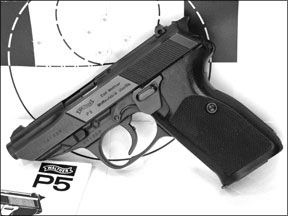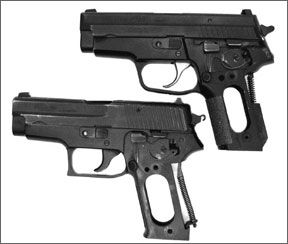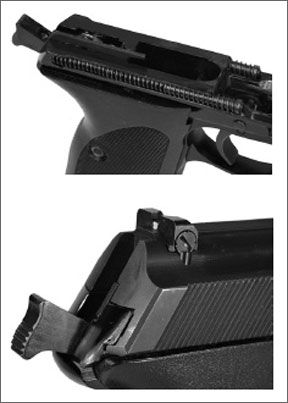Buying a used gun presents a lot of trade-offs: The shooter probably saves money, but in the process, he might buy a gun that’s worn out, rather than worn in. We recently tested three guns we bought used to see how they stacked up against today’s pistols, and if buying one for target or self defense was a wise choice. Simply put, were they shooters or were they collectibles?
To find out, we tested each gun the same way we test current production models. To be honest, some of our staff begrudge the evaluation of used guns, but they had to admit, this was fun
Our test 9mms were the Sig Sauer P225, $525; the Astra A-100, $450; and the Walther P5, at a pricey $650 chunk of change. Each of our test guns were acquired from Fountain Fire-arms in used condition but with the original box and much of if not all of the original paperwork (fountain-?rearms.com). These guns were sold without warranty; all arrived with two magazines, featured a blued finish and plastic grips. The Walther P5 and the Sig Sauer P225loaded fed from single-column magazines, but the Astra A-100 was a high-capacity model.

How We Tested
We fired our usual choice of one economical practice load and two hotter defense rounds. For our budget round, we shot Black Hills Ammunition remanufactured 115-grain FMJ loads. Our defense loads were the aggressive 125-grain HAP hollow points from Atlanta Arms and Ammo, and 147-grain JHP/XTP rounds from Hornady.
Wefired supported from a bench single action only to collect accu-racy data. By today’s standards these guns would be described as compact models. Therefore, we tested at a distance of 15 yards. We also tried an action test at 7 yards firing standing unsupported. The desired point of impact was the rectangular A-zone of an IPSC Metric target measuring 5.9 inches across and 11 inches high. Since each model featured a long double action first shot followed by a shorter and lighter single action stroke, our action test focused on the transition from double to single action. We fired ten strings of two shots each to judge the controllability of the pistol as the trigger changed position and presented less resistance. We were looking for twenty shots inside the A-zone.
In judging these vintage pistols we decided to rate them both in context with one another and also judge them in terms of currently available new-in-box models. Were they shooters, collectibles or both? Here is what we learned.
Sig Sauer P225 9mm $525
The Sig Sauer P225 pistol, also known as the P6, was introduced in 1978 primarily as a law enforcement sidearm developed as a smaller version of the P220. We have not ascertained when our specific pistol was made but one of the biggest differences between today’s Sigarms pistols and yesterday’s Sig Sauer models is the construction of the slide. Most Sigarms models for sale in the U.S. feature a CNC-machined stainless steel slide produced at their Exeter, New Hampshire plant. The P225, however, was fit with a stamped sheet-metal slide ?t with a stamped sheet-metal slide fit with a machined steel breech face pinned into place.
Our P225 still had a very good slide-to-frame ?t, but the ?nish was wearing thin. There were also markings from the importer rudely engraved upon the frame that may have an effect on value. The engraving process had chipped the ?nish, referred to as K-Kote, on the alloy frame.
The P225 fed from a single-col-umn magazine holding eight rounds. The liberally checkered grips were plastic and covered the back of the frame. The slide offered a ?at pro?le ahead of the ejection port. Sights were very similar to what Sigarms now calls Contrast Sights featuring a white dot up front and a white ver-tical line centered below the notch in the rear. Take away the open tang hammer, and the P225 looked like a cross between the midsize P229 wide body and the single-column P239 Sigarms pistols of today. Underneath the grip panels, (held by snubby screws and lock washers which have now disappeared from production), we saw that the P225 was nearly the same as todays Sigarms pistols. Left-side controls were slide release, decocker, magazine release button and disassembly latch. But unlike todays Sigarms pistols, the maga-zine release cannot be changed to right-side operation.
At the range we found that the P225 favored the Black Hills 115-grain FMJ rounds and the 125-grain hollowpoints from Atlanta Arms and Ammo. The 147-grain JHP/XTP Hornady rounds brought out the best and the worst in this gun. The best was the smallest single group of the test (1.0 inches across), but the worst was malfunctions as the older gun had trouble chambering the long, blunt-faced ammunition. The most consistent performer was the 125-grain HAP rounds that pro-duced the smallest variation in group size overall, just 1.3 inches to 2.0 inches across per ?ve shots at 15 yards. This ammunition was also the most powerful producing 328 ft.-lbs. of muzzle energy from the Sig Sauer P225. However, our other two pistols produced more energy ?ring this round, topping out at an average of 1118 fps in combination with the Walther P5.
Our action test was performed with each gun loaded with the Black Hills 115-grain FMJ ammunition. Fourteen shots landed in the A-zone. Four shots were off center to the left and two shots landed fractionally to the right. The P225 felt comfortable in this aggressive mode of ?re, and, frankly, we thought results would be better.

Would we buy this gun as a shoot-able collectible? At $525, the condi-tion of its ?nish was likely holding down its price. But even in 100% condition, we doubt this gun will appreciate in value. As a defense pistol, we would have to take into account Sigarms factory recondi-tioned pistols with modern compo-nents, such as a stainless steel slide, and higher capacity. Furthermore, Sigarms reconditioned guns are war-ranted and priced within about $100 of our P225.
But a number of shooters have remarked that the single-column design is better ergonomically than wide-body models such as the P226 and P229. These shooters are willing to give up some capacity for handling that they feel may lead to better ac-curacy. One opinion is that todays Sigarms single stacks are either over-sized for most shooters, such as the .45 ACP P220, or perhaps a little small for some, our endorsement of the latest P239 in the April 2007 issue notwithstanding. However, in terms of buying an oldie but a goodie, wed pass on the 225.
Astra A-100 9mm, $450
If you glance quickly at an Astra A-100 pistol, you might think that youve just seen a Sigarms P229. But once your eyes settle on the Astra, you will see that there are several distinguishing features that set the two guns apart.
To start, the grips do not wrap around the back of the frame, and the magazine release presses through to the other side when oper-ated. The hammer is relieved with a round hole, and there is a torsion bar spring on the back of the trig-ger. The slide release and decocker are in the same place as on the Sig pistols, but the decocker protrudes so far from the grip that you might think you could use it to hang the pistol from your belt.
The breakdown lever is on the right side of the pistol, opposite of the Sig design and mounted further back directly above the trigger. The rear sight was adjustable for windage only, provided you carry a small screwdriver. When turning the adjustment screw, the body of the sight stays put, and the rear blade complete with two white dots rode back and forth in contrary motion. That is, turning the screw right or clockwise brings the point of impact to the left. The front sight blade was pinned in place and featured a large white dot.
With the top end removed, we saw that the Astra A-100 operated in much the same manner as the Sig Sauer/Sigarms pistols. With the slide locked back, the breakdown latch is rotated and the top end was free. But underneath we saw what appeared to be a cast locking block. Also, the recoil spring was a single ?lament instead of the wound multi-?lament recoil spring used in the Sigs. The multi-?lament Sig spring continues to be trumpeted as key to longevity and reliable cycling. Nevertheless, we did not have any malfunctions with the Astra pistol.
What made the Astra A-100 popular was its price and its capacity. Our A-100 came with two pre-ban magazines capable of holding 15 rounds of 9mm ammunition. According to the Complete Encyclopedia of Pistols and Revolvers by A.E. Hartink (Chartwell Books), the A-100 was introduced in 1993. Our pistol was imported from Spain by Interarms of Alexandria Virginia. As late as 1996 Gun Digest reported its MSRP as being $450, the same amount it was offered for at Fountain Firearms. This gun still has a following today with several internet blogs and chat rooms devoted to buying and trading the A-100.
At the range the Astra A-100 shot groups that measured about 2.5 inches across on average with each choice of ammunition. But the point of impact was well above the point of aim at 15 yards. Shooting from a rest we used a 6 oclock hold aiming at the lowest point on the bull. Shots landed so high we had to place additional paper above the target. Differentiation from point of aim to point of impact was approximately 8.5 inches on average at 15 yards. But at 7 yards the Astra A-100 acquitted itself better than expected in our action test. Sixteen of twenty shots were found inside the A-zone. Missed shots were scattered in all four directions.
Our overall take on the Astra A-100 was that it was not really a quality firearm. But it had come along when high capacity was at a

premium and it was relatively inexpensive. That it can sell for the same amount today as it did when it was new is a testament to its popularity. Still, new parts are not widely available from recognized sources. If high capacity is the attraction, pistols such as the Springfield Armory XD and Taurus Pro series pistols hold even more rounds and sell for less. The Astra A-100 might be adequate in close quarters, but there are better options out there for the same money.
Walther P5 9mm, $650
The Walther P5 was introduced in 1978 and was designed as a law-enforcement sidearm. The P5 utilized a safety system wherein the firing pin is always blocked until the trigger is pulled. Not only does the hammer rest in a position away from the firing pin after each shot (a commonly found safety in todays double-action pistols), but the firing pin remained out of position until the trigger was pressed. With each trigger pull we could see the firing pin rise up into position to be struck by the hammer. (Yes, we did find this distracting at times.) Additional safeties included an automatic firing pin safety and a close safety, which prevented ignition unless the slide was fully closed. Like our other two pistols, the P5 can be fired with a double-action first shot and single action only with the hammer back. The decocker lever for returning the P5 to first shot double action was placed on the frame to the upper right of the trigger guard on the left side of the pistol. The slide lock/release was also on the left located just ahead of the decocker.
In locking back the slide in preparation to remove the top end, we found that the slide release required only a very short, subtle movement. The breakdown latch located on the left side of the dust cover was then rotated clockwise until it clicked into place at the eight oclock position. The relief in the slide latch can now blend with the slide rail and allow the top end to be moved forward off of the frame. Now we had a better view of some of the features and designs that makes this gun of special interest to collectors and engineers alike.
The frame was light even as it carried the recoil assembly consisting of two rods each surrounded by a spring. We may not need to call these rods guide rods because they were supported by the frame embedded along the rails to either side stretching from the rear of the frame to just above the trigger.
Next, we spied a relief in the lower face of the hammer that would allow the firing pin to escape impact when seated in its lower position. Turning our attention to the top end, we sought to remove the barrel by pushing it forward. This brought the front of the slide along with it. Rather than interfacing with a bushing, the barrel was connected via a band to the front of the slide that fit precisely into place. The P5 shared the same locking system as the Walther model P38, referred to as falling block. Other special features included an ejection port that is to the left of center on the slide and a rear sight that was adjustable for windage only. The magazine was held in place by a spring clip at the base of the magazine well.
Included with this gun was its original 25-meter proof target, yellowed with age but still showing the actual tears and grease marks from bullets. The target was signed by the operator. At the time this sight-in target was printed, Walther was producing as many as nine different models in five different calibers. The serial number of our pistol was scrawled on the target with exacting penmanship. Bullet type and weight were not listed, but judging by the small holes in the target, we would guess they were pointed full-metal-jacket rounds that had slipped through the paper without doing much damage. The eight-shot group featured six hits inside the desired point of impact, forming about a 1.2-inch group. One hit was about 2 inches low and another was well left. Our P5 was sold with a Hogue rubber sleeve pulled over the grip. But we found gripping the P5 to be an easy chore with or without the sleeve.
At the range our Walther P5 averaged approximately a 2.25-inch group per five shots in outdoor conditions firing three different types of ammunition. The Black Hills 115-grain FMJ rounds produced the best overall accuracy, but the Hornady 147-grain JHP/XTP rounds printed groups with the least variation in size. The Walther also produced the most power among our test pistols except for one case of being edged out by the Astra by 6 ft.-lbs. of energy.
Our action test was no contest. The Walther P5 eagerly placed eighteen of twenty shots inside the A-zone, with only a single shot slightly high of center and another shot embarrassingly low due to shooter error.
As a tactical weapon for todays world, some could argue that the P5 is too complicated. But as sophisticated as the mechanism was, we thought its structural and functional integrity was sound. Perhaps only its magazine release prevents it from being competitive among defensive-minded consumers.
As a collectible, this gun was a genuine pleasure. We think the Walther P5 earned the right to sell for hundreds of dollars more than either the Astra A-100 or Sig Sauer P225 pistols.



























